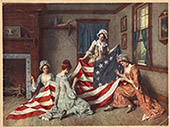Libraries at University of Nebraska-Lincoln
ORCID IDs
Document Type
Archival Material
Date of this Version
1840
Abstract
David Strauss’s Das Leben Jesu (1835) was one of the most influential and controversial theological works of the nineteenth century. It was first translated into English by Mary Ann Evans (“George Eliot”) in 1860, and is said to have been an important early influence on Friedrich Nietzsche. Strauss (1808-1874) applied the methods of German “higher criticism” or textual criticism to the Gospels, and argued that their accounts of Jesus’ miracles and prophecies were to be understood “mythically”—as products of the early church's use of Jewish messianic ideas and expectations to underscore the conviction that Jesus was the Messiah.
Parker’s long (20,000 words) review recaps Strauss’s arguments regarding the birth, genealogy, career, and miracles of Jesus, and places Strauss’s work in the context of German and English theology and philosophy. He writes: “It is not our aim to write a polemic against the author of the “Life of Jesus,” but to describe his book or “define his position,” as the politicians are wont to say. The work in question comprises, first, an Introduction, relating to the formation of “the Mythical stand-point,” from which the Evangelical history is to be contemplated; second, the main work itself, which is divided into three books, relating respectively to the History of the Birth and Childhood of Jesus; his Public Life; his Sufferings, Death, and Resurrection; third, a conclusion of the whole book, or the doctrinal significance of the life of Jesus. … [A] more descriptive title would be, A Fundamental Criticism on the Four Gospels; … it is not a history, but a criticism and collection of materials, out of which a conjectural history may be constructed. … The general manner of treating the subject, and arranging the chapters, sections, and parts of the argument, indicates consummate dialectical skill; while the style is clear, the expression direct, and the author’s openness in referring to his sources of information, and stating his conclusions in all their simplicity, is candid and exemplary.”
While Parker does take issue with the “presuppositions” with which Strauss approached his materials, he nonetheless concludes: “The wonderful ability with which it is written, the learning, so various and exact, wherewith it is stored, are surprising in any one, but truly extraordinary in so juvenile an author; born 1808. For our own part, we rejoice that the book has been written, though it contains much that we cannot accept. May the evil it produces soon end! But the good it does must last forever. To estimate it aright, we must see more than a negative work in its negations. Mr. Strauss has plainly asked the question, ‘What are the historical facts that lie at the basis of the Christian movement?’ Had he written with half this ability, and with no manner of fairness, in defence of some popular dogma of his sect, and against freedom of thought and reason, no praise would have been too great to bestow upon him.”
Controversies over the literal-historical status of the miracles and prophecies of the New Testament played an important role in the evolution of Unitarianism and Transcendentalism. Parker’s review brought the European debate into American homes and pulpits and was an important factor in the development of liberal theology in New England.


Comments
Published originally in the Christian Examiner for April, 1840. Reprinted from The Critical and Miscellaneous Writings of Theodore Parker (Boston: James Munroe and Company, 1843), pp. 248–308.